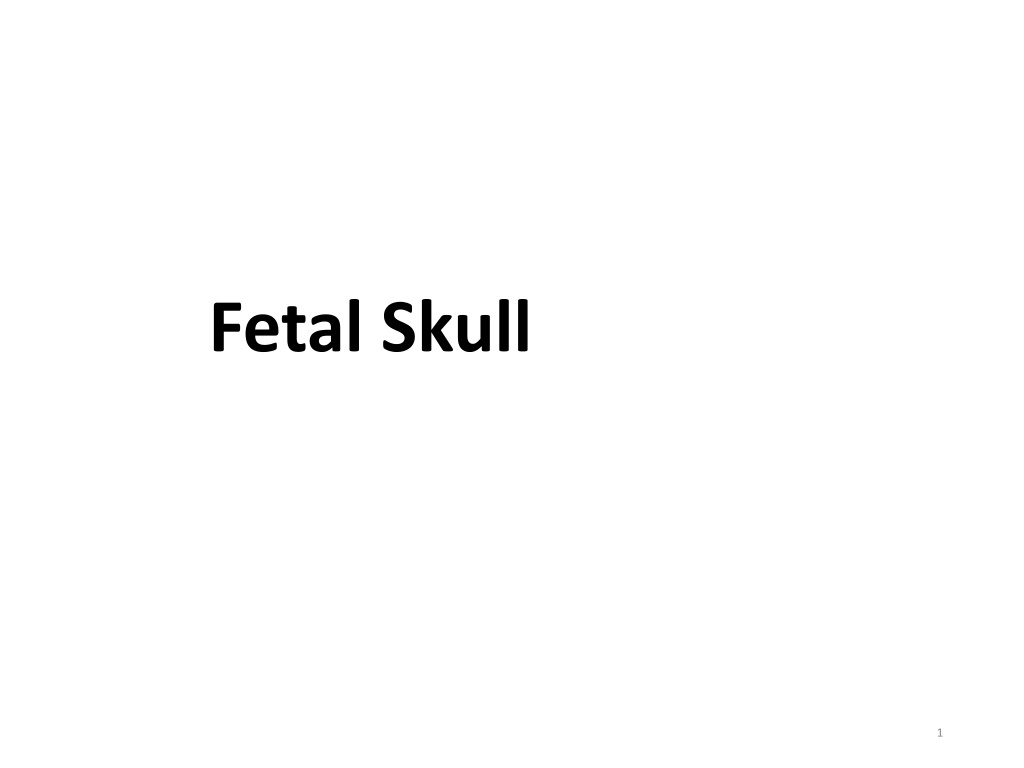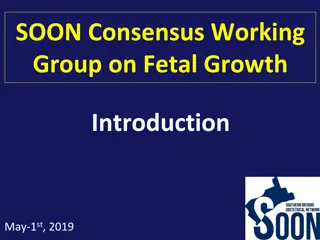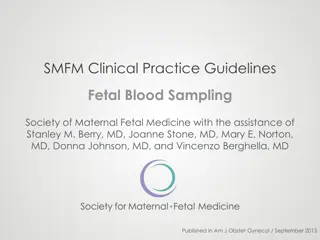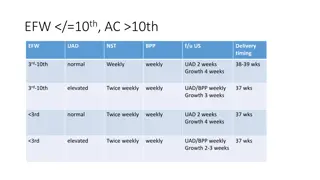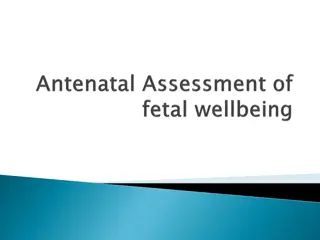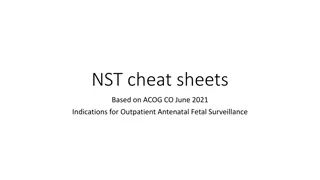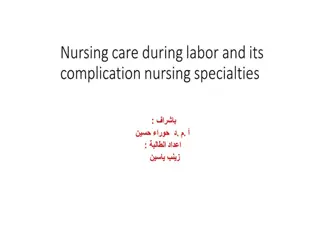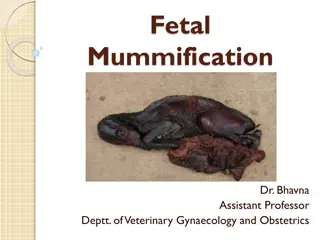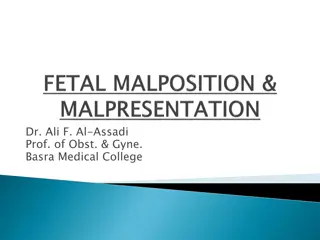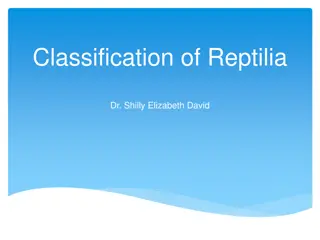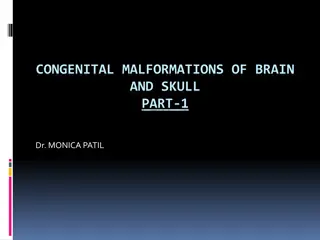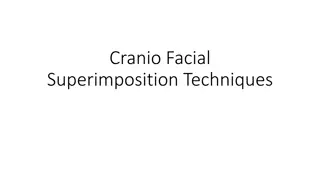Understanding the Anatomy of the Fetal Skull
The fetal skull is a bony cavity that protects the delicate brain and plays a crucial role in the birthing process. This detailed guide explores the composition of the fetal skull, including the bones, sutures, fontanels, regions, and landmarks. Understanding these aspects is essential for assessing labor progression and ensuring proper fetal head presentation during birth.
Download Presentation

Please find below an Image/Link to download the presentation.
The content on the website is provided AS IS for your information and personal use only. It may not be sold, licensed, or shared on other websites without obtaining consent from the author. Download presentation by click this link. If you encounter any issues during the download, it is possible that the publisher has removed the file from their server.
E N D
Presentation Transcript
Fetal skull a bony like cavity which contains & protects the delicate brain. The fetal head is the most difficult part of the body to pass through the mother s pelvic canal whether it comes first or last, due to the hard bony nature of the skull. Understanding the anatomy of the fetal skull and its diameter will help you recognize how a labour is progressing, and whether the baby s head is presenting correctly as it comes down the birth canal. From an obstetrical viewpoint, the fetal head size is important because an essential feature of labor is the adaptation between the head and the maternal bony pelvis. 2
Only a comparatively small part of the head at term is represented by the face. The rest of the head is composed of the firm skull, which is made up of two frontal, two parietal, and two temporal bones, along with the upper portion of the occipital bone and the wings of the sphenoid. These bones are separated by membranous spaces that are termed as sutures. 3
Sutures Are cranial joints. The most important sutures are: The frontal, between the two frontal bones; The sagittal, between the two parietal bones; The two coronal, between the frontal and parietal bones; and The two lambdoidal, between the posterior margins of the parietal bones and upper margin of the occipital bone. 4
Fontanels Fontanels: irregular spaces at where sutures meet together (see the next Fig.). These include The greater, or anterior, fontanel is a lozenge (rhombus) shaped space that is situated at the junction of the sagittal, the coronal and the frontal sutures. The lesser, or posterior, fontanel is represented by a small triangular area at the intersection of the sagittal and lambdoidal sutures. 5
Regions and land marks of the fetal skull Regions and land marks of the fetal skull Skull is divided into vault, base and the face. Vault is large dome shaped part above the imaginary line drawn b/n the orbital ridges and nape of the neck. In the vault the bones are slightly pliable at birth allowing the skull to alter slightly in its shape during birth. The base is composed of bones that are firmly united to protect the vital centers in the medulla. The face is composed of 14 small bones w/c are firmly united and non compressible. 7
Regions and land marks of the fetal skull Regions and land marks of the fetal skull Regions of skull include: Occiput: b/n foramen magnum and the posterior fontanel. The part below the occipital protuberance is known as suboccipital region. Vertex: bounded by the posterior fontanel, the two parietal eminences and the anterior fontanel. Of the 96% of the babies born head first, 95% present by vertex. Sinciput (brow): extends from the anterior fontanel and the coronal suture to the orbital ridges. Face: extends from the orbital ridges and the root of the nose to the junction of the chin and the neck. 8
Diameters of the skull Diameters of the skull 1. Suboccipitobregmatic diameter from below the occipital protuberance to the center of the anterior fontanel (9.5cm) 2. Suboccipitofrontal (SOF): from below the occipital protuberance to the center of the frontal suture (10cm) 3. Occipitofrontal (OF): b/n the occipital protuberance to the glabella (11.5cm) 4. Mentovertical (MV): b/n the chin and the highest point of the vertex (13.5cm) diameter (SOB): 10
Diameters of the skullcontd Diameters of the skull cont d 5. Submentobregmatic (SMB): from the junction of chin and neck to the bregma (9.5cm) 6. Submentovertical (SMV): the diameter from the point where the chin joins the neck to the highest point on the vertex (11.5cm) Biparietal Diameter (BP): b/n the two parietal eminences (9.5cm) Bitemporal diameter (BT): b/n the furthest points of coronal suture (8.2cm) 11
Presenting diameters Presenting diameters Diameters w/c form 90o with the curve of carus. Vertex presentation: when head well flexed, SOB and BP diameters present (both 9.5cm). If head not flexed but erect, OF(11.5cm) and BP. Occurs during OPP Brow presentation: when head partially extended MV (13.5cm) and BT (8.2cm). If it persists vaginal delivery is unlikely. Face presentation: when the head is completely extended, SMB (9.5cm) and BT (8.2cm) in face with mento anterior and sternopregmatic 17cm in Mento posterior 13
Moulding Is change in the shape of the fetal head during its passage through the birth canal Fetal molding refers to the process of overlap of fetal skull bones on each other at the location of certain sutures. Alteration in the shape is possible b/c bones in the vault are slightly pliable allowing diameters of skull to be reduced to some extent In premature, moulding is excessive while in post terms it is less. 14
Molding Molding allows for a reduction in fetal skull diameters by up to 6mms to 1.25cms In fully extended head during vertex presentation, SOB and BP diameters reduced as much as 1.25cm and the MV will be lengthened. Excessive molding can lead to trauma Assessment of molding is one of the parameters used to diagnose cephalo-pelvic disproportion(CPD) Two types of molding- parieto-parietal (PP) and occipito-parietal (OP) 15
Degrees of fetal skull molding during labor Degree Description Significance 0 Skull bones separate from each other No abnormality + 1 Skull bones approximate each other but do not overlap No abnormality + 2 Skull bones overlap but can be separated by the examining hand Can indicate obstruction if in early labor or at high station + 3 Skull bones overlap and cannot be separated by the examining finger Indicator of obstruction 16
References References Current Diagnosis & Treatment Obstetrics & Gynecology. 10th ed. United States of America: McGraw-Hill Companies; 2007. Williams Obstetrics 24th ed. USA: Bennett. Myles' Textbook for Midwives 14th /15th edition, Great Britain. 17
